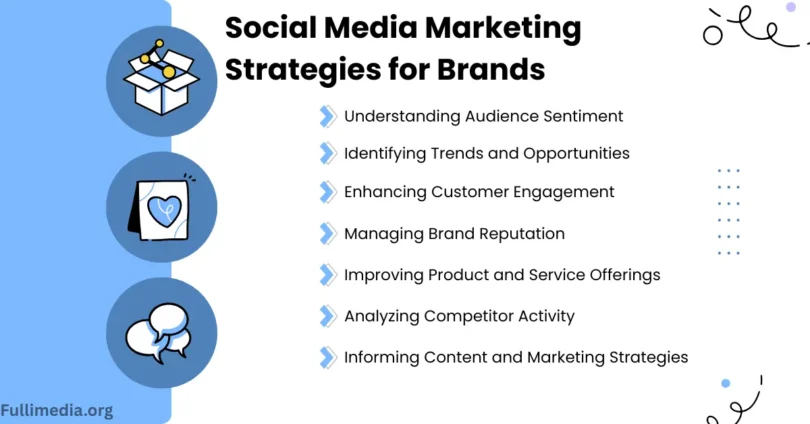Social Media Marketing Strategies for Brands, In today’s digital world, social media has become a powerful tool for brands to connect with their audience. From increasing brand visibility to driving engagement and sales, the right social media strategies can transform a business. Understanding how to plan, create, and share content effectively allows brands to stand out in a crowded online space and build lasting relationships with their customers.
Understanding Your Audience
For any brand, knowing the audience is the first step toward social media success. Understanding who your audience is helps you create content that truly connects and drives engagement. Start by identifying basic demographics like age, gender, location, and language. Then, look deeper into their interests, hobbies, and online behavior.
Tools like Facebook Insights, Instagram Analytics, and Google Analytics can provide valuable information about what your audience likes and engages with the most. Pay attention to patterns in their activity, such as the type of posts they comment on or share, and the time they are most active online.
Setting Clear Marketing Goals
Setting clear marketing goals is essential for any successful social media strategy.
- Specific: Define exactly what you want to achieve, e.g., increase Instagram followers by 20%.
- Measurable: Track progress using metrics like engagement rate, click-throughs, or conversions.
- Achievable: Set realistic targets based on your resources and audience size.
- Relevant: Ensure goals align with your brand’s overall mission and marketing strategy.
- Time-bound: Set deadlines to achieve your objectives, e.g., within three months.
Common social media goals for brands include:
- Boosting brand awareness: Reach more people and make your brand recognizable.
- Increasing engagement: Get more likes, comments, shares, and interactions.
- Driving conversions: Encourage followers to take specific actions like signing up or purchasing.
By defining clear goals, brands can focus their efforts, measure success accurately, and adjust strategies when needed.
Selecting the Right Social Media Platforms
Choosing the right social media platforms is crucial for reaching your target audience effectively.
- Facebook: Ideal for brands targeting a broad audience with mixed content like posts, videos, and ads.
- Instagram: Great for visual storytelling, lifestyle, fashion, and youth-oriented brands.
- LinkedIn: Best for B2B businesses, professional services, and networking.
- TikTok: Perfect for creative, short-form video content targeting younger audiences.
- Twitter/X: Useful for news, updates, and engaging in trending conversations.
Consider your brand type, audience behavior, and content style when choosing platforms. It’s better to focus on a few platforms and do them well than to spread efforts thin across many.
Paid Advertising Strategies
Paid advertising is a powerful way for brands to reach a larger audience quickly. Unlike organic posts, paid campaigns allow precise targeting, helping brands connect with the right people at the right time.
Benefits of Paid Social Media Ads
- Wider reach: Your content appears to users beyond your followers.
- Targeted audience: Ads can be shown based on location, age, interests, and online behavior.
- Measurable results: Platforms provide analytics to track clicks, impressions, and conversions.
Popular Paid Advertising Options
- Facebook & Instagram Ads: Boost posts, run carousel ads, or create story campaigns.
- LinkedIn Ads: Sponsored content and InMail campaigns for B2B marketing.
- TikTok Ads: Short, creative video campaigns targeting younger audiences.
- Twitter/X Ads: Promote tweets to increase visibility and engagement.
When used strategically, paid advertising can amplify your social media presence, attract potential customers, and achieve measurable business results faster than organic methods alone.
Monitoring and Analytics
Monitoring and analytics are essential to understand how your social media strategies are performing. Without tracking results, brands cannot know what works and what needs improvement.
Key Metrics to Monitor
- Engagement: Likes, comments, shares, and saves indicate how well your audience connects with content.
- Reach and Impressions: Measure how many people see your posts and how often.
- Conversions: Track actions like website visits, sign-ups, or purchases generated from social media.
- Follower Growth: Monitor how your audience size increases over time.
Tools for Analytics
- Platform Insights: Facebook, Instagram, LinkedIn, TikTok all provide in-built analytics.
- Google Analytics: Helps track website traffic coming from social media channels.
- Third-Party Tools: Tools like Hootsuite, Sprout Social, and Buffer provide deeper insights.
By regularly analyzing performance, brands can refine their strategies, increase engagement, and achieve better results. Analytics turn raw data into actionable insights, ensuring social media efforts are effective and ROI-focused.
Adapting to Trends
Social media is constantly evolving, and brands that adapt to trends stay ahead of the competition. Following trends helps your content feel fresh, relevant, and engaging for your audience.
1. Why Adapting to Trends Matters
- Keeps your brand visible in a fast-moving digital space.
- Attracts new followers who are interested in trending topics.
- Boosts engagement through formats users currently enjoy.
2. Popular Trends to Consider
- Short-form videos: Platforms like TikTok, Instagram Reels, and YouTube Shorts are highly popular for bite-sized content.
- Interactive content: Polls, quizzes, and live Q&A sessions increase engagement.
- AI-powered tools: AI can help create content faster, suggest hashtags, and optimize posting times.
- User-generated content: Sharing content created by followers builds authenticity and trust.
Brands that adapt quickly and strategically to trends can capture audience attention, strengthen their online presence, and maintain a competitive edge in social media marketing.
Case Studies of Successful Brands
Studying real-life examples helps understand how social media strategies work in practice. Successful brands show how planning, creativity, and consistent effort lead to measurable results.
1. Nike – Engaging Storytelling
- Nike uses social media to share inspiring stories that connect emotionally with their audience. Through campaigns highlighting athletes, achievements, and social causes, Nike creates content that resonates widely, increasing engagement and brand loyalty.
2. Starbucks – Community Interaction
- Starbucks actively engages with customers on social media by responding to comments, sharing user-generated content, and running interactive campaigns. This approach builds a strong community and keeps customers involved with the brand.
3. Wendy’s – Humor and Virality
- Wendy’s Twitter account is famous for witty, humorous posts. By staying true to their brand voice and responding in creative ways, Wendy’s captures attention, encourages shares, and maintains high engagement.
4. Glossier – Influencer Collaboration
- Glossier partners with micro-influencers who align with their brand values. These collaborations showcase real experiences with their products, generating trust and driving sales through authentic recommendations.
Common FAQs about Social Media Marketing Strategies for Brands
1. Why is understanding the audience important for social media marketing?
Understanding your audience helps create content that resonates, increases engagement, and targets the right people for your brand.
2. What are SMART goals in social media marketing?
SMART goals are Specific, Measurable, Achievable, Relevant, and Time-bound objectives that guide your campaigns for clear and measurable results.
3. How do I choose the right social media platforms for my brand?
Select platforms where your target audience is most active and where your content style fits best, like Instagram for visuals or LinkedIn for B2B services.
4. What types of paid advertising can brands use?
Brands can use platform-specific ads such as Facebook Ads, Instagram Ads, LinkedIn Ads, TikTok Ads, or Twitter/X Ads to reach a wider audience and achieve measurable results.
5. How can I monitor social media performance effectively?
Use analytics tools like Facebook Insights, Instagram Analytics, Google Analytics, or third-party tools to track engagement, reach, conversions, and follower growth.
6. Why should brands adapt to social media trends?
Adapting to trends like short-form videos, interactive content, or AI tools keeps your content fresh, relevant, and engaging for your audience.
Conclusion
A strong social media presence comes from understanding your audience, setting clear goals, creating engaging content, and adapting to trends. Consistency, monitoring performance, and learning from successful brands ensure growth, engagement, and lasting impact online.
Written By: Fullimedia



